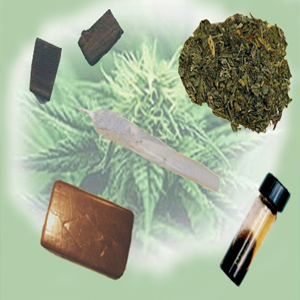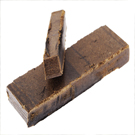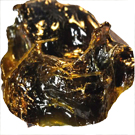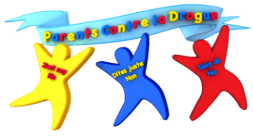
| |
| |
What is cannabis?
Cannabis is the Latin name of hemp. It is a plant native
to Central Asia, specifically the foothills of the Himalayas,
which is used by man for thousands of years in the Far East and
the Middle East.
Cannabis is an annual herb,
theoretically dioecious (there are male and female feet feet).
It belongs to the family of cannabinoids (the family includes
only two genera: hemp and hops).
|
| |
|
Cannabis comes in 3 forms: |
| |
|
|
 |
|
THE
MARIJUANA
(pot, joint, marie-jeanne, herb,
grass, ganja) :
Came from the stem, are the dried
flowers and leaves of the Cannabis Sativa plant.
Its colors can go from green gray to brown
greenish. The substance contains usually seeds
and stems. Strong smell. Marijuana is often
smoked in hand-rolled cigarettes (joint,
firecracker), or in pipes, but it can also be
eaten in bakery recipes. The content of THC
changes according to the amount of cannabis,
0,1% to 15% and 25% to 30% with the new
hydroponics techniques. |
| |
|
|
| |
|
|
 |
|
THE HASHISH
(Hasch, H, shit) :
Extract of the resin segregated
by the cannabis, the hashish is sold only in
form of a cube or in pieces where the color goes
from light brown to black. Its texture can go
from dry and hard to soft and crumbly. It’s
usually mixed with tobacco and smoked. Is more
powerful than marijuana because it has a higher
content of THC, 12% to 20%. |
| |
|
|
| |
|
|
 |
|
THE HASHISH
OIL
:
It’s a concentrated of hashish,
viscous and thick, a dark green, brown or black
liquid, obtained by percolation from purified
hashish with an organic solvent or alcohol. Its
THC concentration level is very high, from 60%
to 80%. Hashish oil is added to joints to
increase its power.. |
|
| |
| |
Consumption
form :
Inhalation : joint (hashish or
tobacco cigarette or just marijuana) or "bang" (water
pipe).
Ingestion : drinks (tisane, mixture with milk) or dishes,
bakery (space cake), jams.
|
|
|
|
|
What
are
the
effects? |
|
Category :
Disruptive |
Caractéristics
:
The active element of Cannabis is the
Delta 9 THC (tetrehydrocannabinol). The leaves have 2 to
7% of it, according
to the geographic
origin of the plant
(25 to 30% with the
new Dutch cultures
called "Nederwiet".
The resin has from 10 to 25%. The oil extract has about
60%.
Cannabis
is a narcotic,
say an euphoriant substance, harmful to
health. It causes dependence. Because its elimination is
slow, the symptoms of lack are moderated. Detoxification
is a long term process during which the regular cannabis
user suffers for months consequences of psychological
order. |
|
|
|
General
order effects:
These
are four phases:
|
|
● |
|
Euphoric excitement, well-being
moral and mental sensation, expansive communicative joy. |
|
● |
|
Sense and affective exaltation,
disorientation that carries hashishtique intoxication
with hilarity and phases and disturbance of the time and
space notion.
|
|
● |
|
Ecstasy and bliss. |
|
● |
|
Depression and sleepiness.
Took
in small quantities, cannabis generates a state of
euphoria and dream and open appetite.
Audio and
visual perceptions can be modified.
In regular use,
behavior and mental functions disturbance can be
noticed. The individual loses his self-control, the
sense of reality, the notion of time and space. |
|
|
|
Effects
over
the
brain:
THC carries biochemical changes.
By
acting over the action of the
neurotransmitters,
it alters the delicate balance between the pleasure
center (limbic cells) and the command, reflection center
(neo-cortex).
That explains the deceleration of the
intellectual interest, certain indifference, the social
life distance, the periodical phases of euphoria
followed by periods of apathy and depression more and
more longs.
|
|
|
Effects over the respiratory
functions:
The excessive use of joint (5 to 10 per
day) can bring, in a year, sinusitis and chronic
bronchitis that a 20 to 40 years tobacco smoker meets in
5 to 10 years.
He is ten times more predisposed to
have lung or aero digestive tract cancer.
Effects over the inmunitary system:
THC causes inhibition in the lymphocytes
reproduction, blood white cells that carry the
antibodies needed to fight infection diseases. In a
normal individual, 5.9% is in constant reproduction.
In a cannabis user this percentage drops to 2.3%.
The
immunitary system gets weak and lets an open field to
virus and microbes.
Dependence:
Regular cannabis users can develop a
psychological dependence; the consumption of the
drug becomes their center of interest. Their
tolerance rate increases, needing always more
drug quantities to feel the same effects. In the
physical plan, dependence remains slow in spite
of certain symptoms related to detoxification
during the stoppage of cannabis use: | | |



